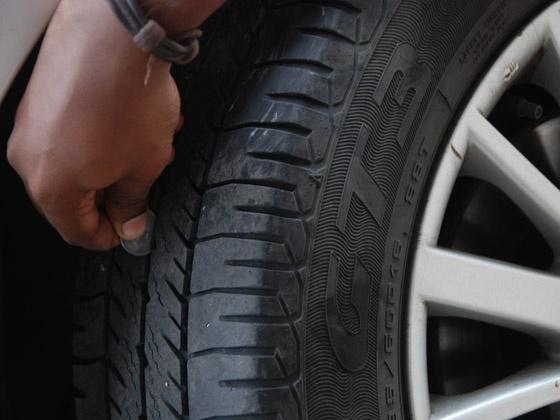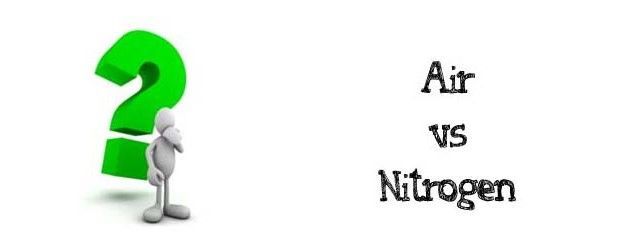Tyre maintenance
Published On Dec 29, 2012 03:31 PM By Rahul
- 4.4K Views
- 1 Comments
- Write a comment
- Tubeless tyre puncture kit
Over the years, better quality tyres have reduced the possibility of a flat tyre though they aren’t entirely avoidable. It is best to be prepared against such eventualities to avoid the hassle of changing tyres. All puncture repair should be restricted to the tread area only and never on the side wall.
In the case of tubeless tyres, one can use puncture repair kits that come with the tyres or can be bought off the shelves from any tyre shop. These kits usually comprise a spiral tool, an inserting tool, a strip of puncture seals, a tube of rubber cement and a sharp blade. Some kits also have additional tools such as compressed air canisters with covers, valve adapter, etc. Besides, it will be a good idea to buy an electronic tyre inflator.
Here's a step-by-step guide to repairing a punctured tubeless tyre.
1. Inflate the tyre and locate the puncture by checking for any sharp objects like nails or glass shards.
2. Remove the foreign object and any other things that may be sticking out of the tyre.
3. Take the spiral tool and drive it into the puncture in a clockwise manner. This will make it easier to insert the puncture strip.
4. Remove a puncture seal from the strip, feed it through the inserting tool like a needle and thread.
5. Once the seal strip is equal on both sides of the inserting tool, take the tube of rubber cement and apply it to the centre of the seal strip. The inserting tool has a little gap at the bottom that will allow the seal strip to be left behind inside the tyre.
6. Remove the spiral tool from the tyre and insert the inserting tool with the seal strip. The inserting tool will not go all the way in. It will stop after the plastic bit of the handle touches the tyre after which it can be pulled out. At this point, the seal strip will be left inside the tyre blocking the hole in the tyre.
7. The sharp blade should then be used to cut off the ends of the seal strip sticking out of the tyre for an even contact patch for the tyre.
8. Set the appropriate tyre pressure on the tyre inflator and inflate the tyre.
The tyre is now repaired with the vehicle ready to be driven but do get the tyre checked up at a repair shop.
- One rupee coin test
This test is quite effective to check your car's tyre for irregular wear and tear

In order for a vehicle to deliver the best fuel efficiency every part of the car needs to work like well oiled machinery. It's always a good idea to visit your local workshop for regular tyre and air pressure checks but at times can be quite a hassle. Fortunately today all modern cars come with a tread wear indicator. Though there's another option to check the health of a tyre through a one rupee coin.
Here's a guide to doing it yourself.
Take a one rupee coin and put it in the tread for all 4 tyres. See how deep the coin goes.
In an ideal situation, the tread depth is uniform in each tyre. But in case there is considerable difference in the tread depth, chances are that rubber is being burnt away in that particular tyre.
The best remedy to this is to get the alignment and balancing done. Irregular tyre wear and tear happens mostly due to driving on bad roads and the best way to reduce it is by getting the wheel alignment and balancing checked every 3,000 kilometres or when you notice the car is not able to maintain a straight line.
Another factor that signals irregular wear and tear of the tyre is when you feel a change while stopping the car. Three wheeled brakes is a sure shot signal that the tyre wear and tear is irregular. Three wheeled brakes happen primarily in two scenarios: when there is irregular tread wear from one of the tyres and when there's a problem in the brake hub of that particular wheel.
Whether a tyre tread has lived its life or not is indicated by the wear indicator but also enough attention has to be paid on the pattern of the tread wear.
- Alignment
Wheel alignment

Alignment is key for a good tyre condition as incorrect alignment can result in rapid tyre wear and can even affect the handling and safety of the vehicle.
Wheel alignment can be affected by driving against a kerb, hitting a pothole in the road or by excessive wear to steering or suspension components. Alignment of wheels and tyres to the specification required by your vehicle is an important way to guarantee a smooth ride and to get the most out of your tyres.
The direction and angle at which tyres are set are both important. Wheel alignment or 'tracking' involves checking the direction and angle against vehicle manufacturers' specifications. These are often described as toe in, toe out, positive camber or negative camber.
"Toe" refers to whether the front of the tyres are closer or further apart than the rear of the tyres. Different types of vehicles need different toe settings to allow for the way that wheels pull either towards each other or apart.
"Camber" is the inward or outward tilt of a tyre. The camber is set by the vehicle manufacturer, and can be affected by potholes in the road and may need to be adjusted periodically.
- Balancing
Wheel balancing

The first sign that your wheels may be out of balance is when your steering wheel starts to wobble above a certain speed. The light weight of modern cars means that they don't dampen down the vibrations caused by spinning wheels in the way that older, heavier vehicles could.
Wheels that are not balanced or are out of balance generally produce a vibration that is uncomfortable to drive in and results in premature wearing of suspension and steering components, rotating parts and tyres.
Correctly balanced wheels help to eliminate vibration and avoid premature wear caused by an imbalance in the rotating wheel and tyre assembly.
- Rotation
Tyre rotation
Many tyre manufacturers agree that it is no longer good practice to rotate your tyres in order to extend their legal life. The reasons

for this are:
=> Partly worn tyres are more likely to experience punctures – particularly in wet weather conditions.
=> Front tyre deflation will create an under-steer effect which is easier to control than over-steer (the effect produced by a rear tyre deflation)
In the unlikely event that a tyre deflates suddenly, then it is easier to control the vehicle if this occurs at the front of the vehicle. For improved handling and stability it is now recommended that the ‘best' tyres should always be fitted at the rear of the vehicle. This is irrespective of whether the car is front or rear wheel drive.
- Safety Tips
Safety First
'Tyres are your only point of contact with the road surface, so you cannot afford to neglect them.' We recommend that you should check the condition of your tyres regularly - at least once a fortnight.
Why should you check your tyres?
Worn tyres significantly impede the performance of your car - low tread depths reduce the effectiveness of braking, steering, and acceleration, all of which are vital in staying safe. Hat What are a few minutes put aside now to check your tyres, when you compare it to your own safety and that of your family?
What Should I Check?
1. Check overall condition of tyres, including inner and outer sidewalls.
2. Check tyre tread depth.
3. Check all tyre pressures.
4. Check signs of irregular wear.
5. Check and examine the spare tyre.
Tyre Pressures
A tyre does not have to look flat to be under inflated. To be safe you should check the pressure at least once a fortnight. If you are unsure as to what the correct pressure is for your vehicle, have a

look in the Vehicle Manual. Having the correct pressure in tyres will ensure you get a good fuel efficiency from your car.
=> Always remember that tyre pressure should only be tested when your tyres are cold
=> If you drive around on under or over inflated tyres, your vehicle's handling will be seriously affected
=> The wrong tyre pressure also increases tyre wear, significantly shortening its lifespan and increasing the chances of the tyre failing whilst driving.
Wheel Alignment
If your tyre is evenly worn across the surface, then this could be a sign of over/under inflation. However, if it is only worn on one edge it is likely to be the result of poor wheel alignment. If this is the case you need to have a professional garage check your tracking.
Wheel Balancing
An unbalanced wheel can cause dangerous mechanical damage. Make sure wheel balancing is done after fixing the tyres.
Tread Depth

However, the deeper the tread the more grip you will have when driving. It is unsafe to ignore the minimum tyre tread depth, which will be mentioned in the User manual. There is a simple test you can perform to test the tread depth of you tyres and the best part is that the device fits snugly into your pocket – a 1 rupee coin.
To test, take a 1 rupee coin and place it in-between the main grooves of the tyre. If you can see the outer band of the coin, the tyre may have insufficient tread depth. At this point, it is advised that you have your tyres checked over by a qualified mechanic.
Spare Tyre
Even if you never use your spare tyre it is still vital that you check that it is in good condition and that you have one in the car. Check the pressure and the tyre tread periodically.
It is better to discover any problems in a safe and comfortable environment, i.e. at home, than by the roadside
0 out of 0 found this helpful






